Dell XPS 15 L521X: A Detailed First Look
by Jarred Walton on July 25, 2012 1:10 AM ESTDell XPS 15 Gaming Performance (with ThrottleStop)
This is where things get a bit messy and confusing. The CPU throttling on BIOS version A01 through A04 is a severe enough problem that out-of-box gaming performance on the XPS 15 is substantially lower than expected. In most games that we tested, CPU throttling kicks in after anywhere from 30 to 90 seconds, at which point the CPU sits at 1.2GHz until you exit the game. This makes benchmark results highly variable, with the first run always being the fastest, and frankly it’s unacceptable. How this slipped through the cracks on a shipping laptop is something of a mystery, as it took all of five minutes with DiRT 3 and Batman: Arkham City for me to determine something was wrong with performance, and to then track down the root cause. OEMs take note: both games have built-in benchmarks and your performance labs should be using these and other high-profile games to check performance before you start shipping product. End of discussion.
Now, with that out of the way, we wanted to see what the XPS 15 could do with a bit of fine tuning on CPU clocks. Under the default settings on the A04 BIOS, CPU temperatures topped out at 80C, which is lower than we’ve seen on quite a few laptops. Furthermore, CPU clocks were almost always 2.8GHz (maximum Turbo Boost for four threads or more on the i7-3612QM) before throttling down to 1.2GHz, which seems rather myopic. The whole point of Intel’s Turbo Boost is to let the CPU run at the maximum sustainable clock speed without overheating, and right now that’s not happening.
A bit of tinkering with ThrottleStop 5.0 Beta 3 yielded CPU temperatures in the 80-90C range with a 23X multiplier, with some games capable of running at 2.5 or even 2.6GHz without overheating. Again, this isn’t something an end user should be required to use in our opinion, but thankfully it does allow substantially improved performance and it’s easy enough to enable/disable as needed. Depending on the game in question, we saw performance improve by anywhere from 10% to over 100% by using a 23X multiplier with the CPU PROC HOT signal disabled—Batman and DiRT 3 showed the greatest improvements. Note also that the difference at higher quality settings isn’t as large, as the GPU becomes more of a bottleneck. We have 1080p “Enthusiast” results for the XPS 15 as well as our 768p “Value” and 900p “Mainstream” scores, but in most games 1080p Enthusiast wasn’t playable so we won’t report those scores for now. Let’s start with our Value and Mainstream results, and then we’ll list “recommended” settings and frame rates for the XPS 15 running at 1080p.
Value Gaming Performance
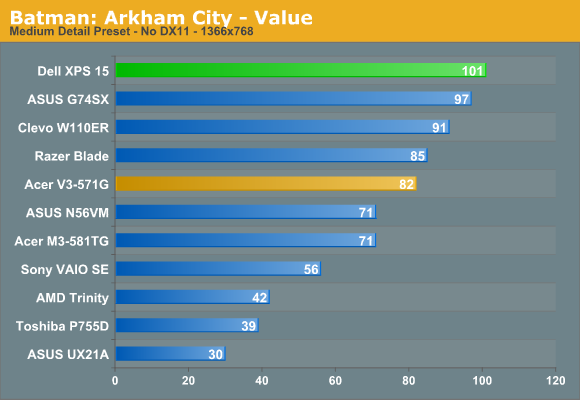

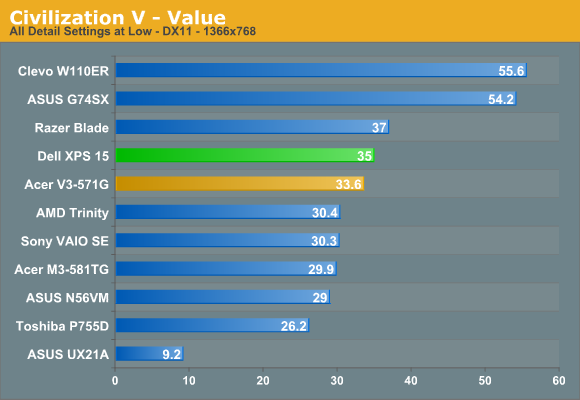

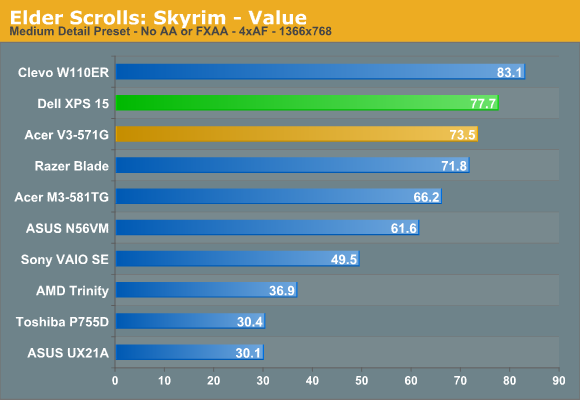
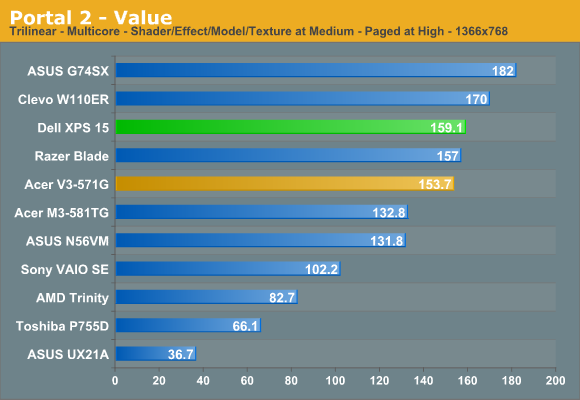
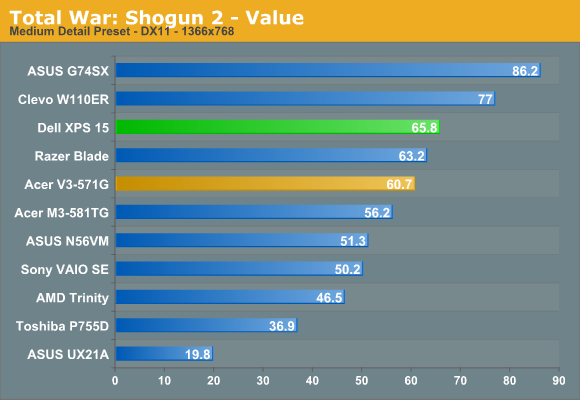
Our Value settings don’t pose any problem for the XPS 15, with all games easily besting 30FPS and most surpassing the 60FPS mark. The XPS 15 basically sweeps the table against the Acer V3, showing the value of using GDDR5 memory instead of DDR3 memory on the GPU. Also worth note is that Civilization V performance continues to be a bit quirky with certain driver versions; the original 296.01 drivers couldn’t even break 30FPS regardless of setting on the XPS 15, while the newer 304.79 beta drivers at least let you get 35FPS. One quick look at the W110ER results however shows that we ought to be able to get performance closer to 50FPS. I ran FRAPS while performing the Civ5 “lategameview” benchmark at one point to see what was going on, and for some reason performance appeared to fluctuate between 50FPS and 35FPS, where normally the frame rate is pretty steady. I’d guess a future NVIDIA driver will address the issue.
Mainstream Gaming Performance
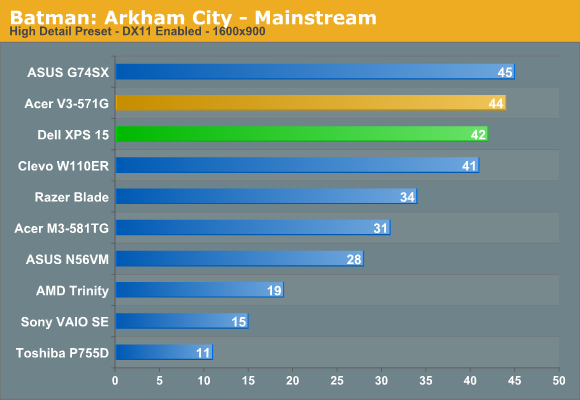
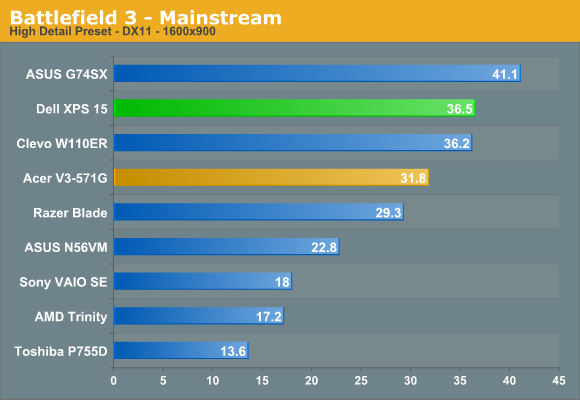
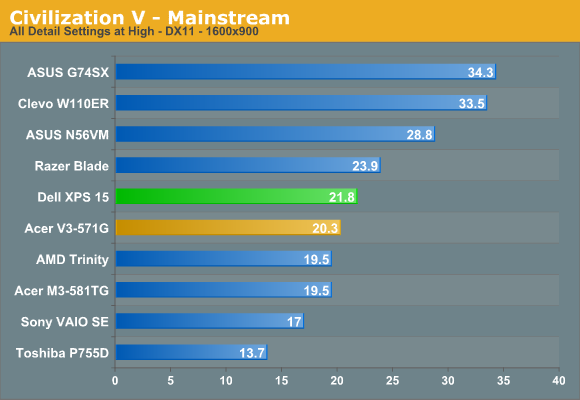
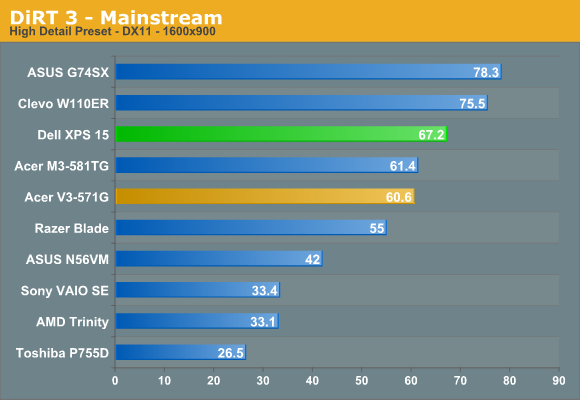
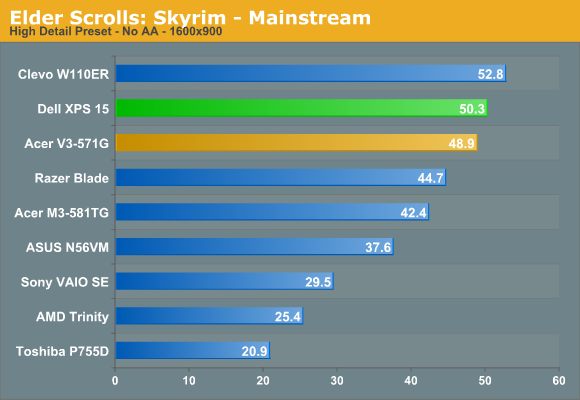
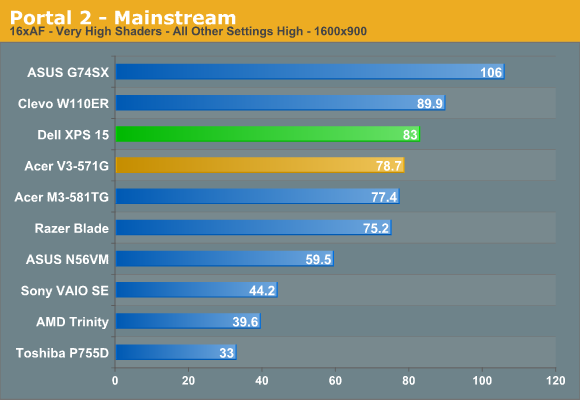

Mainstream performance generally follows the same pattern, only with lower frame rates. The GT 640M with GDDR5 is close to handling all of our test suite at 900p “High” details, with Battlefield 3 and Civilization V being the only two games where we’d recommend dropping to lower detail settings (and again, the drivers are likely a factor in Civ5 performance). It’s also interesting that the Acer V3 manages to eke out a win in Batman, indicating our lowered CPU clocks might be coming into play. Otherwise, the use of GDDR5 is typically able to improve GT 640M performance by an average of 8%, with up to 25% higher performance in at least one game (Batman using our Value settings).
|
Dell XPS 15 Gaming Recommended Settings for 1920x1080 |
|||
| Game | Detail | FPS | Notes |
| Batman: Arkham City |
Very High + 4xAA |
46 |
DX11 and PhysX both tend to be too much for the GT 640M, but you can max everything else out and maintain smooth frame rates. |
| Battlefield 3 |
Medium (“Value”) |
32.6 |
Single-player is okay at these settings, but multi-player will need to drop the resolution or use custom settings with some items on Low. |
| Civilization V | Low (“Value”) | 32.3 |
Civ5 needs a better driver, and we’ve seen higher scores in the past. Until then, setting everything to “Low” is your best bet for 1080p. |
| DiRT 3 | High + 4xAA | 45.8 |
Very fluid at the High defaults with 4xAA. If you try Ultra without AA, you’ll be closer to 30FPS. |
| Portal 2 | Max + 4xAA | 57.8 |
You can pretty much max out the settings in Portal 2 and still maintain fluid frame rates. |
| Skyrim | Ultra + 4xAA | 30.8 |
Skyrim is playable at 30FPS, and so our Enthusiast defaults work well enough. If you want slightly higher performance, you can use FXAA instead of 4xAA and get 35 FPS. |
| Total War: Shogun 2 |
High (“Mainstream”) |
34.8 |
The “High” preset seems to work best, though “Very High” with AA disabled is also viable. |
Most of the games’ settings are straightforward, but a couple warrant further explanation. In Batman, enabling Very High with PhysX is borderline playable, with an average frame rate of 27 FPS; DX11 without 4xAA is a similar 26 FPS, and enabling 4xAA in either mode drops a few FPS whereas FXAA is basically free. Civ5 performance is still a bit chaotic (see below), so take those scores with a grain of salt for now. Finally, our test scene in Skyrim happens to be one of the lowest performing areas we could find, so while we report 30 FPS there are many areas in the game that will run in excess of 60 FPS.
As mentioned earlier, Civilization V and Total War: Shogun 2 ran better with the most recent 304.79 beta drivers, and that’s what we used for the above settings. The remaining games all ran best with the official 296.01 Dell drivers, though at some point we expect to see a new WHQL driver that will provide the best of both worlds (and hopefully further improve Civ5 performance). Not shown in our charts is another popular game, Diablo III; given that the Acer V3 could handle maxed out settings, the same holds for the XPS 15. With GDDR5 memory, the GT 640M ends up being around 10% faster on average compared to DDR3; it can certainly handle gaming at 1080p, but in many games you’ll need to lower the detail settings somewhat to be fully playable.










109 Comments
View All Comments
robco - Thursday, August 2, 2012 - link
You had some decent, respectable opinions, until that dig in the last line. Plenty of people who know how to use computers use Macs - especially the laptops. There are lots of people who fire up Terminal and use the CLI. Lots of *nix software works on OS X - because it is BSD. I know plenty of engineers sporting MacBooks. The stereotype of only computer novices using Macs is a tired one.As for proprietary hardware, that's the case with most laptops. They're not like desktops where you can assemble one from standardized, interchangeable components. Sure the CPUs, drives and RAM may be, but not the motherboard, cooling system, case, GPU, battery, etc. You can't mix and match the parts you like about different Dell, HP and Lenovo laptops and make a Frankenstein box like you can with a desktop. Laptops are sold more or less as complete packages. You can get DIY kits in different sizes, but you're just installing the CPU, drives and RAM. There's a lot less choice.
Luke2.0 - Saturday, August 4, 2012 - link
Hi, Jarred. Good first look. Well done.But I miss the audio / speaker test (You did it for the N56 Preview). You see, Dell was leveraging on their JBL speakers back then. And it helped their 2010 XPS15 to earn AT's gold medal.
How about the current offering?
I would love it be mentioned again, especially when you are going to update and finalize the review. Even if the testing would be somewhat reviewer-subjective, still I'm gonna appreciate your effort.
Thank you.
JarredWalton - Thursday, August 9, 2012 - link
The speakers are good, better than the 15z, but not as good as the original XPS 15 (L501x/L502x). I think that's because the last XPS 15 had a dedicated subwoofer, where this version does not. That's too bad. So basically, the earlier XPS 15 had a (much) better 1080p display, better audio quality, but worse build quality and aesthetics (though some of that is certainly subjective). Of course, with the proper power adapter, the original XPS 15 didn't have any issues with throttling that I experienced.alfling - Wednesday, August 8, 2012 - link
BIOS A06 is out! Could you please give it a try and tell us how it is in gaming? Thank you!ftp://ftp.dell.com/FOLDER00719182M/1/L521XA06W.exe
JarredWalton - Thursday, August 9, 2012 - link
Interesting... where did you get that link from? Dell sent me a couple beta versions of A05 that didn't fix the throttling issues (actually, they throttled the GPU instead of the CPU, which was even worse for gaming). I haven't heard anything from them for the past 10 days or so, though, so I'm not sure what the current status is. I'm guessing that A06 is another beta, but I'll give it a shot and report back shortly....JarredWalton - Thursday, August 9, 2012 - link
Okay, I only tested with DiRT 3, because that's been very good at showing the throttling. It looks like the A06 (beta?) you linked is better than the A05 betas I've played with, but I can see exactly what Dell is trying to do and I don't like it. With the CPU and GPU loaded (i.e. playing a game), the CPU is no longer throttling. At all. So throughout 10 minutes of running DiRT 3 tests, the CPU always had at least one (usually two or three or all four) CPU cores running at 2.8GHz (2795.5-2795.9 MHz to be precise). The problem is the CPU is thus still generating a decent amount of heat, and in order to compensate Dell is throttling GPU clocks.Looking at the GPU, after about 2.5 minutes (and over half of that time is spent launching DiRT 3), the "GPU Geometry Clock" drops from 708.8 (Boost Clock) to 669.8 MHz (still boosting but not as much), and then about 10 seconds later it drops to 615 MHz (now slightly lower than "stock"), and after a few more seconds it drops way down to 405MHz. There are even times where the GPU clock drops down to 270 MHz -- so basically running at less than half the expected GT 640M clock speed. At the same time, the GPU Memory Clock starts at 1000.4 MHz (4GHz effective) and stays there for the first 2.75 minutes, and then the clock starts to fluctuate between 1000MHz and 400MHz.
Ultimately, you get a much better gaming experience with the CPU running at a steady 1.8GHz with the GPU at maximum clocks than dropping GPU clocks while leaving the CPU at max -- so from that perspective, the A04 BIOS is still better, especially if you're willing to play with ThrottleStop.
Temperatures incidentally are higher than I saw with A04 -- I'm seeing a maximum of 92C on the CPU (but the throttling causes the temps to drop quite quickly after that to around 85C). and the GPU tops out at around 81C. And this is all just in 10 minutes of testing. But then, I'm using the built-in DiRT 3 benchmark, so let me try actually playing the game to see if that's any different....
JarredWalton - Thursday, August 9, 2012 - link
So, as expected the issues carry over into the actual gameplay, and in fact the GPU throttling is even worse than I at first suspected -- not that it occurs more frequently, but that it really messes up the experience. I'm still seeing steady 2.8GHz CPU clocks with the GPU usually at 405MHz after the first couple of minutes, but the GPU memory going back and forth between 1000MHz and 400MHz causes very noticeable fluctuations in frame rates. One second everything will be going smoothly, and the next you feel the lag and the slower frame rates, and then it kicks back to higher speed.... It might not be as bad in some other games, but in DiRT 3 it makes it very hard to drive a consistent line, with the game actually slowing down and speeding up. Ugh.I also tried the A06 BIOS with ThrottleStop, and while it took longer for the GPU to throttle, it did after a few minutes. Then it stayed at 405MHz most of the time (with one 10 second drop to 270MHz), and the VRAM was more commonly at 1000MHz, but the 400MHz VRAM clocks do show up periodically and really mess with the gaming experience.
So in short, A06 is still beta in my book, and I prefer A04 with the CPU throttling rather than A06 with GPU throttling.
On a different note, when I flash the BIOS there's clearly one higher fan speed that kicks in that I'm not seeing in normal use. At this point, Dell should be looking at CPU clocks in gaming workloads closer to 2.1GHz and they should be running the maximum fan speed once the CPU core hits 80C. I'd be okay if they limited the CPU clock to 2.4 GHz any time the GPU clock was higher than 270MHz, personally -- it's not ideal, but it's far better than what's currently happening.
Flunk - Sunday, August 12, 2012 - link
Hi Jarred, I have one of these and your experiences above mirror what I'm seeing. I've had 2 different L521x units in my house and they both perform identically (first one had a bad screen).Even if you set the CPU speed to 99% in power options to prevent boosting on A06 (which is up on their standard page now) it still downclocks the GPU in much the same way.
Frankly it is quite infuriating that Dell would sell such and obviously flawed product in the first place. There is no reason to have a dedicated graphics chip if you can't use it.
At this point I'm hoping that they get back to me and tell me they're going to replace the thermal solution because it doesn't seem like they can figure out how to do this with a BIOs update.
Thanks for bringing this up in your review, the more pressure Dell has on them to fix this the better.
alfling - Tuesday, August 14, 2012 - link
Did you experience any drops in battery life with A06 BIOS? I ask because of this post in notebookreview:http://forum.notebookreview.com/dell-xps-studio-xp...
alfling - Tuesday, August 14, 2012 - link
Thank you very much! I got the link in Notebookreview forum from an XPS 15 owner (not sure how he got it, but he shared it)